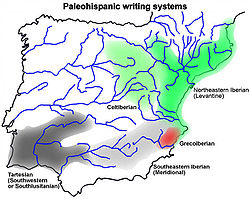Greco-Iberian alphabet

The Greco-Iberian vowels.
Location of findings
Alcoi
).The inscriptions that use the Greco-Iberian alphabet had been found mainly in
). The archaeological context of the Greco-Iberian inscriptions seems to concentrate in the 4th century BC, but the paleographic characteristics of the model indicate that the adaptation may date from the 5th century BC.Typology

The Greco-Iberian alphabet contains 16 signs identical to Greek signs, except for the sign corresponding to the second
nasal sign. To represent the second rhotic , rho gets an additional stroke. Eta is used instead of epsilon to represent /e/. The only letter not found in the modern variant of the Greek alphabet is sampi
.
The letter forms are petroglyphic since the writing surface (ceramic, stone, lead) affords angular glyphs with straight lines.
| Vowels | Occlusives | Sibilant, Rhotic, Lateral | Nasal | ||||
|---|---|---|---|---|---|---|---|
| Alpha | Α | Gamma | Γ | Sampi | Ϡ | Nu | Ν |
| Eta | Η | Kappa | Κ | Sigma | Σ | ||
| Iota | Ι | Tau | Τ | Rho’ | Ρ̓ | ||
| Omicron | Ο | Delta | Δ | Rho | Ρ | ||
| Upsilon | Υ | Beta | Β | Lambda | Λ | ||
See also
- Celtiberian script
- Iberian languages
- Iberian scripts
- Northeastern Iberian script
- Southeastern Iberian script
- Tartessian script
- Paleohispanic languages
- Pre-Roman peoples of the Iberian Peninsula
Notes
Bibliography
- Gómez-Moreno, Manuel (1922): «De Epigrafia ibérica: el plomo de Alcoy», Revista de filología española 9, pp. 341–366.
- Hoz, Javier de (1987): «La escritura greco-ibérica», Veleia 2–3, pp. 285–298.
- Hoz, Javier de (1998): «Epigrafía griega de occidente y escritura greco-ibérica», Los griegos en España, pp. 180–196.
- Rodríguez Ramos, Jesús (2005): «Introducció a l’estudi de les inscripcions ibèriques», Revista de la Fundació Privada Catalana per l’Arqueologia ibèrica, 1, pp. 13–144.
- Untermann, Jürgen (1990): Monumenta Linguarum Hispanicarum. III Die iberischen Inschriften aus Spanien, Wiesbaden.
- Velaza, Javier (1996): Epigrafía y lengua ibéricas, Barcelona.
